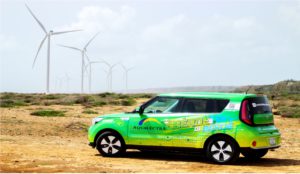
AQUALECTRA EVs
Estimated Savings:
Nafl. 3,320 per year on fuel expenses per EV
Our fleet size: 16 EVs
Introduction
EVs (‘Electric Vehicles’) consist out of BEVs (‘Battery Electric Vehicle’) and PHEV’s (‘Plug-in Hybrid Electric Vehicle’). It offers its users both the chance to reduce their CO2 –footprint and, depending on the gas prices, electricity rates the opportunity to save on their gas expenses.
Currently, the transport sector consumes roughly 50% of the total petroleum fuel imports of Curaçao. This means that a shift from conventional vehicles to energy efficient EVs would benefit the local community significantly leading to a robust community which will be less dependent on fossil-fuels.
Role of Aqualectra
Aqualectra N.V. is studying the possibility of an electrified transport sector. We decided to be progressive within this transition and replace 16 conventional vehicles with EVs. These EVs are the first step in better understanding the ins and outs of the technology and actively report the findings to the local community.
In order to have a transition from conventional vehicles with Internal Combustion Engines (‘ICE’) to EVs, we need to better understand the following:
- The performance;
- The safety; and
- The potential savings
Benefits of EVs
EVs have a wide variety of benefits compared to conventional ICE-vehicles. Some examples are:
- Saves you money on your gas expenses;
- Reduces tail-pipe emissions;
- Can be used to store solar energy;
- EVs react more quickly (faster acceleration);
- EVs can be charged exactly as your smart phone at home or at work;
- By charging often, you don’t have to go to a gas station;
- EVs require less maintenance;
- Electric motors don’t require oil change and oil filters;
- Are more quiet (less noise); and
- Reduces our dependence on fossil fuels.
Mileage EV vs. ICE


